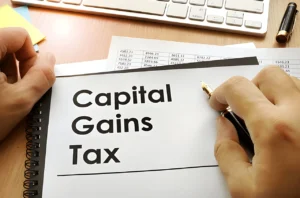Contents
For most people, buying a house is the most significant and proudest purchase of your life. All of the meticulous measures you took—innumerable property visits, contract dealings and examinations – to show up at the fantasy of homeownership. With house prices at an all-time high, many people are seeing this as an ideal opportunity to sell their home. However, did you realize that houses are viewed as a capital resource, subject to capital gains tax?
CGT is paid on the profit gained after you dispose of or sell your property, although it generally doesn’t apply if you have been using the property as your main residence. For example, if you purchased a buy-to-let property ten years ago for £250,000 and sell it now for £500,000, CGT would be applied on the £250,000 difference between the two. This article will give you a rundown of paying CGT and how to avoid it on buy to-let property.
“The most significant hit on buy-to-let charge has come from the limitation on finance costs overall and home loan alleviation, specifically ”
Who pays the CGT?
“Customarily, you don’t have to pay any GCT when you sell your main (or essential) home. ”
There are a few exceptions to this for main residences. If you have sub-let part of your home (having a visitor doesn’t count) or used a piece of your home as business premises, you will be expected to pay some GCT. If you figure this may concern you, we propose you search for capital gains charge counsel. Anyone that disposes of or sells assets worth over the CGT allowance should be aware of the rules.
These assets can include:
- Personal assets worth over £6,000, excluding your vehicle
- Any property that isn’t your principal living place
- Investments and offers not held in an ISA (Individual Savings Account) or PEP (Personal Equity Plan)
- Some business resources
“When offering a buy to-let, the essential center is accomplishing the most tremendous cost and accordingly your profits on your buy to-let and limiting your property manager charge. ”
Landowners need to put forth their best attempt to introduce their buy to-let as a fair and livable property. If you focus on proprietor occupiers, the buy to-let property should not resemble an investment property and instead, a possible home that is perfect, inviting and promptly occupiable.
If you expect that you will offer your buy-to-let to another landowner, you should downplay embellishment and ornamentation. Similarly, as a landowner looking to lease your property, you need to be extreme to get the buy to-let to the greatest number of expected occupants.

Reliefs on buy-to-let?
You can avoid CGT by using the following:
- Lettings Relief
- Private Residence Relief
Lettings Relief:
When part of a house is let out, then the increase from selling it might be subject to capital gains tax. If the owner continued to live in the property, Lettings Relief can be applied to help with decreasing the capital gains tax (CGT) bill. Another way to cope up with excessive tax is joint tenancy, in which joint occupants have an equivalent say in choices about the property.
In the event that one passes away, the property is consequently acquired by the other joint occupants. Changing from possessing a home or buy-to-let property from a joint tenure to occupancy can offer tax savings, but you should continue to take professional advice to ensure the results match your expectations. Lettings help facilitates the proportion of the expansion brought into charge on the expulsion of a property, which at some point or another during the hour of ownership has been the resident’s simply or central home and part or the whole of that property has ultimately during the hour of request been let as personal comfort.
The assistance thoroughly applies where:
- Part of the aggregate of the property has ultimately been left as private accommodation during that individual’s season of ownership.
- A chargeable increment arises by the uprightness of the letting.
The proportion of the assistance is the lower of:
- The amount received from Private Residence Relief
- £40,000
- The amount generated in profit due to letting out part of your home
Private Residence Relief:
Numerous people understand that an individual’s primary home is not subject to CGT – under the Private Residence Relief rules (PRR help). PRR easing can, in specific conditions, offer more comprehensive CGT benefits to shrewd property monetary patrons.
For example, landowners offering a buy to-let property may have the alternative to take advantage of PRR easing if they have lived in the property for some time. If the property has recently been the individual’s main residence for part of the period of ownership, then the proportion of private home assistance is reduced; this infers that piece of the increment may be chargeable to CGT.
PRR easing also allows you to ensure help on the latest nine months of ownership as CGT is barred if you have verification that the property was at some point or another your primary living spot sometimes.
How to reduce CGT?
There are legitimate ways to reduce the amount of Capital Gains Tax (CGT) payable
- Losses made
- Spouse allowance
- Maximize CGT allowance
- Solicitor fee
- Advertisement costs
- Stamp duty cost
- Capital items costs
“Everybody, including children, have a yearly CGT exemption.”
This CGT allowance currently rests at £12,300 and is frozen at this level until 6 April 2026. Subsequently, if your total capital gains this tax year or in all of the going with four evaluation years are inside that aggregate, you’ll follow through on no obligation. These taxes can be deducted from your capital increment. There are moreover certain appraisal reliefs available. For example, if the property was in advance your main residence, the amount may be lessened.
Like Income Tax, any expansion is articulated on your Self-Assessment authoritative document. The evaluation is along these lines, payable by 31 January in a perpetual time after the obligation year in which the property was sold. (For instance, if a property was sold in September 2019, it is contained in the year till April 2020, so the evaluation is payable before the end of June 2021).
Capital gains tax when selling a buy-to-let property

Buy-to-let properties are dependent upon capital gains tax (CGT). For properties, this is charged at a rate of 28% (for higher-rate citizens) or 18% (basic rate citizens) on any development in esteem that the property has appreciated. If you’re a basic rate citizen, remember that the increase will be added to your pay, which could drive you into a higher-rate band.
Everybody has a tax-exempt capital gains allowance of £12,300 for the tax year 2021-22, so you’ll have to pay CGT on gains over this edge. It’s also conceivable to balance a few taxes, such as what you paid out for stamp obligation and conveyancing when you buy the property and any accuses related to selling it (counting home specialist charges). Likewise, you ought to have the option to balance any capital enhancements you’ve made to the property against your CGT bill. You’re not permitted to deduct outgoings on the upkeep of the property or home loan interest.
The following should be kept in mind before buying or selling a BTL property
Stamp Duty: At the point when you’re purchasing a property you don’t mean to live in as the main home – for example, a buy-to-let property or occasion/second home – you’ll need to pay 3% extra in stamp duty. The principal particular case for this is individuals who’ve never claimed property and are putting resources into buy to-let property as first-time buyers, who will pay standard home mover rates. Second-home and buy-to-let stamp obligation rates are layered, as private stamp obligation rates and annual assessment.
You can look at the current buy to-let stamp obligation rates for financial backers in England and Northern Ireland in the picture underneath and discover the amount you’ll pay with our stamp obligation adding machine.
Estate agent fee: If you sell your home utilizing a conventional estate agent, its tax will generally be determined as a level of the cost paid by the buyers. This sort of estate agent tax is called commission. The average commission is 1.42% of the last selling value (inc VAT), as per a July 2018 overview by house-selling site The Advisory.
Notwithstanding, this figure can fluctuate from under 1% to as much as 3.5%, contingent upon various variables – including the number of domain specialists are selling your property. Domain specialist charges used to be cited ‘in addition to VAT’ more often than not (which means you needed to add 20% on top of your statement). However, runs from The Property Ombudsman that happened in October 2016 express that reports should now consistently incorporate VAT.
On the off chance that your statement doesn’t make it clear in any case, always check.
Mortgage interest: Buy to-let contracts are a lot like standard home loans, but there are also significant differences. The taxes will in general, be a lot higher. Interest rates on buy to-let contracts are typically higher. The most minor store for a buy to-let contract usually is 25% of the property’s estimation (despite shifting between 20-40%).
Most BTL contracts are interest-only. It implies you pay the interest every month, except not the capital sum. Towards the finish of the home loan term, you reimburse the first advance in full.
BTL contracts are additionally accessible on a reimbursement promise. The Financial Conduct Authority doesn’t manage most BTL contract loaning (FCA). There are exceptional cases, for instance, on the off chance that you wish to let the property to a nearby relative (for example, companion, common accomplice, youngster, grandparent, parent, or kin). These are frequently alluded to as buyers buy to-let contracts and are surveyed by similar severe moderateness rules as a private home loan.
“As of April 2020, you are presently not ready to deduct any of your home loan costs from rental payments to decrease your tax bill.”
CGT Exceptions on buy-to-let property:
If you are thinking about having exemptions in your CGT then here you go;
Can I change my elected residence to reduce buy-to-let CGT?
- If you had possessed property as a buy to let for, let’s say, ten years then it could bode well to move into it for some time as my Principal Private Residence “PPR”.
- Let’s say you bought the property for £100,000 and it is presently worth £200,000, this is a £100,000 capital gain if you manage to sell the property while never having lived in it.
- Subject to having the option to demonstrate it had, sooner or later, been your Principal Private Residence, then you would be qualified for guaranteed PRR help.
- You would likewise have the option to guarantee “Letting Relief” at a similar figure or £40,000, whichever is the lower. Fortunately, every individual can ensure to let alleviation.
- Finally, remember that every proprietor additionally has a Capital Gains Tax yearly exception remittance which can likewise be utilized to lessen the available increase.
- This is a VERY valid justification to take proficient exhortation!

Should I sell my property with a tenant or vacant?
To a great extent, a landowner is in every case better offering their buy-to-let property with empty belonging (without any occupiers including occupants). The explanation is that the property will interest both proprietor occupiers and financial backers or landowners. Assuming you do sell the property rented, you are restricting its market to different landowners.
Curiously, throughout the most recent couple of years, there has been an expanding quantity of designers who have designated property financial backers and landowners by building properties with ensured yields (proposing an occupant is set up).
Selling property with tenants:
On the off chance that you have arrived at the stage where you need to sell a rental portfolio, then, at that point, you could end up confronting some difficulties. Contingent upon the end buyers, private investment property, in contrast to business resources, frequently sells best with empty belongings. On the off chance that your properties are completely rented, life can turn somewhat more troublesome.
You will realize that any financial backer purchasing with occupant set up will commonly be searching for something like a 10% markdown on the value that could be accomplished on the off chance that you sold with empty belonging. The hard truth is you presumably will not be honored with a long line of buyers willing to take on your inhabitants.
“You might be unable to discover a buyer who will trade contracts if your occupant is still set up, particularly if that inhabitant has shown reluctance to collaborate and is off-kilter.”
Selling property as Vacant:
The major drawback of offering a tenanted buy-to let without its occupants is that you have to delay until the current tenure terminates or until it finishes lawfully. Contingent upon your inhabitants and the occupancy, understanding this could require some investment, as well as being muddled and costly. Sitting occupants don’t need to co-work with the selling system.
Occupants are also not obliged to permit valuers, assessors, home specialists, or expected buyers, into the property. Regardless of whether a condition in the occupancy permits this, they don’t need to offer admittance to your property with or without early notification.
As most property ventures will ultimately be sold with tax to pay on the increases, CGT is an urgent thought for financial property backers. On the off chance that you don’t have a financial plan as expected for CGT on the buy-to-let property and are looking for how to avoid CGT on buy-to-let property, make yourself mindful of impending authoritative changes, as they can prompt an unwanted and sudden tax responsibility, in addition to falling foul of HMRC. Continuously talk with an expert duty consultant well ahead of your choice to offer a venture property to see approaches that can limit your local tax liabilities, including CGT.
As we say, the definitive point is to accomplish the fine harmony between altering your tax and augmenting your riches. There are further, more confounded reliefs you might be qualified for, like EIS help, yet given the intricacies required here, it is enthusiastically suggested you look for tax experts or advisors such ourselves.
References
(n.d.). Retrieved from London Residential Magzine: https://www.theresident.co.uk/news/21487511.capital-gains-tax-something-need-pay/
CGT on property. (n.d.). Retrieved from gov.uk: https://www.gov.uk/capital-gains-tax
Express. (n.d.). Retrieved from: https://www.express.co.uk/finance/personalfinance/1472772/rishi-sunak-hmrc-capital-gains-tax-receipts-rise-cgt-costs
Fifth of BTL landlords consider exit. (n.d.). Retrieved from Financial Times: https://www.ftadviser.com/mortgages/2021/07/05/fifth-of-btl-landlords-consider-exit/?page=1
Mortgages on buy-to-let property. (n.d.). Retrieved from Money Helper: https://www.moneyhelper.org.uk/en/homes/buying-a-home/buy-to-let-mortgages-explained
Property wire. (n.d.). Retrieved from: https://www.propertywire.com/news/property-jargon-buster/
Tax when you sell home. (n.d.). Retrieved from GOV.UK: https://www.gov.uk/tax-sell-home










16 responses
I bought a BTL 10 years ago for £200k. I moved into the property recently current value £350k
I intend to sell in 18months time. When I sell do I have to pay CGT for the period I did not live in it i.e the difference between £200k and £350k.
Hi Geroge,
Thank you for your enquiry here in respect of your Buy-to-Let property. The 10 years letting period of the property, will not create a relief against the capital gains. The only availability you will have will be for private residence, if this property was nominated as your main residence since acquiring it back to live in.
If you wish to understand in details on the tax position, you can drop us your contact details on hello@legendfinancial.co.uk and one of our tax advisors will be in touch.
Many thanks,
Saiqa
Can I claim expenses made in a different tax year to when my buy to let is sold against cgt?
Dear Janice,
Thank you for your query here.
The capital expenses are normally considered at the time of sale, when computing the capital gains tax.
With respect to your comment, I can only confirm if I can have a bit more understanding with respect to the expenses.
Should you wish to discuss this further, please drop us an email on hello@legendfinancial.co.uk and one of our tax advisors will be in touch with you.
Many thanks,
Fahad
We have a buy to let for which we have had an offer for purchase by a developer with exchange of contracts not for 18 months. We were advised that to reduce some portion of the CGT there might be a way by taking out a remortgage on the current property jointly with the daughter of the current owner and if the daughter uses those proceeds to purchase a residential property to live in then when the current property is technically sold in 18months then the portion she used of the remortgage is not assessed for CGT. The current property is in the sole name of the father.
Can this be true?
Thanks
Hi Kulin,
Thank you for your comments here.
Technically speaking, CGT only looks at the gains with the acquisition/disposal costs and the ownership percentage share in the property; with the mortgage it is out of the equation.
I hope this helps, however if you wish to discuss anything in detail; please drop us an email on hello@legendfinancial.co.uk with your contact details and availability & we can organise it further.
Thank you
Fahad
Thank you this is helpful. I will be in touch separately in due course as needed.
Can you change from a buy to let mortgage to a residential mortgage if you are planning to live there and will you then have to pay capital gains tax on it if you subsequently decide to sell the property?
Dear Dee,
Thank you for contacting Legend Financial.
The mortgages can certainly be changed depending on the circumstances, the best way to have a conclusion on it is to speak directly to the lender/bank and/or the mortgage advisor.
With respect to the capital gains tax, it will be due on any residential property sale. The only way it can be reduced if it was used as a private residence, there were major refurb. Costs and other aspects of the property – this can be discussed in detail.
Should you wish to speak further, please email us on hello@legendfinancial.co.uk and let us have your contact number along with a suitable time/date and we can then arrange a call.
Many thanks
Saiqa
Dear fahad
Very useful information thank you ,I had a question which I am very confused & stressed about !
Father bought a buy to let property on his name for me 10 years ago which has increased in value by £200000 . I didn’t like the property and want him to sell it now and I want to get another property but he doesn’t want to due to capital tax bill . Is there any way Around for him to avoid the bill . I was assuming if he gifts it to me and I make it my permanent residence for a year and then sell it but after abit research I realised I think he still will be liable to pay .. please can you advice me a way around it as I hate that property and he doesn’t wana get rid of due to the bill !
Any info will be greatly appreciated sir
Dear Ali,
Thanks for your comment. I understand the situation however since the legal owner of the property is still your father he will still be liable to capital gains tax even if he disposes it or gifts it.
Should you wish to speak further. we can arrange a call, and if you can kindly share your contact details and a suitable time/date on hello@legendfinancial.co.uk ; one of our tax advisors will be in touch with you.
Thank you
Fahad
If you sell buy to let property to buy a bigger buy to let property do you still have to pay CGT
Dear Subhash,
Further to your enquiry about selling an existing buy to let property and purchasing another one which is more in value, assuming the property is not used in the trade, was solely with a view to generate rental income and on the personal or joint name. In this case, the property will be charged Capital Gains Tax at 18% up to a basic rate tax limit and above 28%.
The purchase cost along with all refurbishments to the point of sale will be deducted from the proceeds. The selling cost is also a deductible expense. The remaining amount will be subject to CGT.
Please do not hesitate should you require any information.
Regards
Fahad
Question, if i sell my BTL property to buy another BTL which is more expensive do i pay CGT?
Dear NAKRANI,
Assuming the property was purchased solely with a view to generate rental income. In this case, the property will be charged Capital Gains Tax at 18% up to a basic rate tax limit and above 28%.
The purchase cost along with all refurbishments to the point of sale will be deducted from the proceeds. The selling cost is also a deductible expense. The remaining amount will be subject to CGT.
Please do not hesitate should you require any information.
Regards
Fahad
Very useful information regarding CGT. This above helps to avoid CGT by using the channel of reliefs.